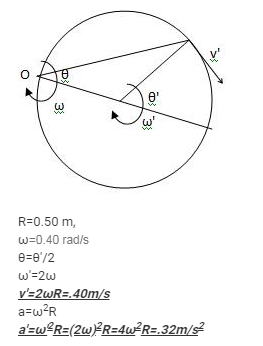Class 9 Exam > Class 9 Questions > A particle of A move along the circle of radi...
Start Learning for Free
A particle of A move along the circle of radius R= 50 cm so that it it's radius vector r relative to the point O (figure) rotate with the constant angular velocity v =0.40rad/s then the modulus of the velocity of the particle and modlus of total accerlation a will be?
Most Upvoted Answer
A particle of A move along the circle of radius R= 50 cm so that it it...

R=0.50 m,
ω=0.40 rad/s
θ=θ'/2
ω'=2ω
v'=2ωR=.40m/s
a=ω^2R
a'=ω^2R=(2ω)^2R=4ω^2R=.32m/s^2
Community Answer
A particle of A move along the circle of radius R= 50 cm so that it it...


|
Explore Courses for Class 9 exam
|

|
Similar Class 9 Doubts
Question Description
A particle of A move along the circle of radius R= 50 cm so that it it's radius vector r relative to the point O (figure) rotate with the constant angular velocity v =0.40rad/s then the modulus of the velocity of the particle and modlus of total accerlation a will be? for Class 9 2025 is part of Class 9 preparation. The Question and answers have been prepared according to the Class 9 exam syllabus. Information about A particle of A move along the circle of radius R= 50 cm so that it it's radius vector r relative to the point O (figure) rotate with the constant angular velocity v =0.40rad/s then the modulus of the velocity of the particle and modlus of total accerlation a will be? covers all topics & solutions for Class 9 2025 Exam. Find important definitions, questions, meanings, examples, exercises and tests below for A particle of A move along the circle of radius R= 50 cm so that it it's radius vector r relative to the point O (figure) rotate with the constant angular velocity v =0.40rad/s then the modulus of the velocity of the particle and modlus of total accerlation a will be?.
A particle of A move along the circle of radius R= 50 cm so that it it's radius vector r relative to the point O (figure) rotate with the constant angular velocity v =0.40rad/s then the modulus of the velocity of the particle and modlus of total accerlation a will be? for Class 9 2025 is part of Class 9 preparation. The Question and answers have been prepared according to the Class 9 exam syllabus. Information about A particle of A move along the circle of radius R= 50 cm so that it it's radius vector r relative to the point O (figure) rotate with the constant angular velocity v =0.40rad/s then the modulus of the velocity of the particle and modlus of total accerlation a will be? covers all topics & solutions for Class 9 2025 Exam. Find important definitions, questions, meanings, examples, exercises and tests below for A particle of A move along the circle of radius R= 50 cm so that it it's radius vector r relative to the point O (figure) rotate with the constant angular velocity v =0.40rad/s then the modulus of the velocity of the particle and modlus of total accerlation a will be?.
Solutions for A particle of A move along the circle of radius R= 50 cm so that it it's radius vector r relative to the point O (figure) rotate with the constant angular velocity v =0.40rad/s then the modulus of the velocity of the particle and modlus of total accerlation a will be? in English & in Hindi are available as part of our courses for Class 9.
Download more important topics, notes, lectures and mock test series for Class 9 Exam by signing up for free.
Here you can find the meaning of A particle of A move along the circle of radius R= 50 cm so that it it's radius vector r relative to the point O (figure) rotate with the constant angular velocity v =0.40rad/s then the modulus of the velocity of the particle and modlus of total accerlation a will be? defined & explained in the simplest way possible. Besides giving the explanation of
A particle of A move along the circle of radius R= 50 cm so that it it's radius vector r relative to the point O (figure) rotate with the constant angular velocity v =0.40rad/s then the modulus of the velocity of the particle and modlus of total accerlation a will be?, a detailed solution for A particle of A move along the circle of radius R= 50 cm so that it it's radius vector r relative to the point O (figure) rotate with the constant angular velocity v =0.40rad/s then the modulus of the velocity of the particle and modlus of total accerlation a will be? has been provided alongside types of A particle of A move along the circle of radius R= 50 cm so that it it's radius vector r relative to the point O (figure) rotate with the constant angular velocity v =0.40rad/s then the modulus of the velocity of the particle and modlus of total accerlation a will be? theory, EduRev gives you an
ample number of questions to practice A particle of A move along the circle of radius R= 50 cm so that it it's radius vector r relative to the point O (figure) rotate with the constant angular velocity v =0.40rad/s then the modulus of the velocity of the particle and modlus of total accerlation a will be? tests, examples and also practice Class 9 tests.

|
Explore Courses for Class 9 exam
|

|
Signup to solve all Doubts
Signup to see your scores go up within 7 days! Learn & Practice with 1000+ FREE Notes, Videos & Tests.





















